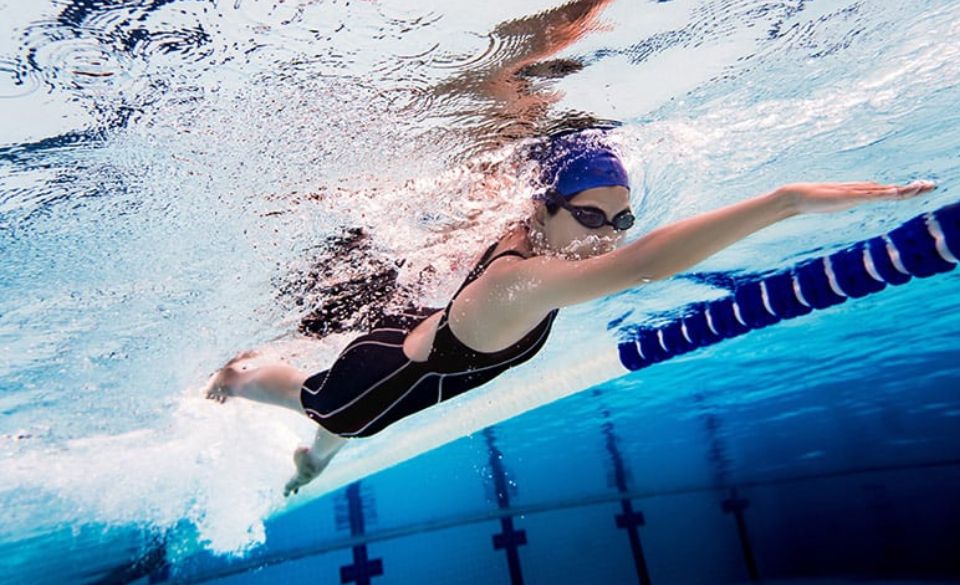
Does Swimming Build Muscle – What Should You Know
Page Contents
The quick answer to the question “does swimming build muscle?” is yes. Since you are trying to go forwards through the water, swimming is essentially a form of resistance exercise. This will eventually result in favourable muscle growth if performed repeatedly, as with other resistance workouts. But you might need to increase the intensity of the resistance if you want to develop bigger muscles.
Swimming is a great, low-impact workout for losing weight and improving fitness. It’s perfect for people who have injuries, joint troubles, or other conditions that make weightlifting and aerobic workouts challenging. Swimming is typically thought of as a method to develop lean muscle, but if you’re seeking to bulk up but can’t take a more demanding training schedule, is swimming still a viable option.
In this article we still tackle some questions such as;
– Does Swimming Build Muscle
– Muscles Used In Freestyle Swimming
– Muscles Worked While Swimming Breaststroke
– Muscles Used In Swimming Butterfly
– Running Vs Swimming Muscles Used
Does Swimming Build Muscle
You build muscle as a result of resistance training when they stretch, break down, and repair. Swimming is a resistance workout like weightlifting, but unlike weightlifting, there is a lot less stress applied your bones and joints.
This may lessen the amount of muscle you gain quickly, but it also has a smaller negative impact on your body, which is a significant advantage of continuing to be physically active throughout your life.
Any sort of exercise that involves resistance from an outside source, like swimming, can help you build muscle. So when you ask “Does Swimming Build Muscle?” the answer is yes but not as much or as quickly as heavy weight lifting could.
However, muscular growth from swimming alone would be limited. This means that if swimming is your main form of exercise, your muscular growth may plateau.
The same way you would have upper body strength days and lower body strength day with weight training, your swim training should have similar plans if you want swimming to build muscle.
Use a kickboard while swimming to focus on your legs. Your arms will only be needed to maintain your balance; your legs will do all the work of propulsion. This is great for engaging your core and improving the core muscles needed for successful swimming.
Use a pull buoy to develop your arms; it isolates your arm muscles and helps you work out harder. Swimming makes it difficult to completely ignore the leg muscles, but this form of training will help you develop your arms’ muscles more swiftly.
Muscles Used In Freestyle Swimming
The most popular swimming stroke is freestyle. Triathletes and open water swimmers both favour this stroke the most.
In the pool, freestyle is also a great exercise. It is quite taxing and will have a significant impact on your deltoids, latissimus dorsi, trapezius, triceps, and biceps.
Tall people benefit greatly from the stroke’s rotational movements. Freestylers use their hands as paddles to push back the water as each leg moves up and down in opposite direction pushing them forward. Freestylers use their biggest muscle groups in their arms and legs to move forwards.
The shoulders, torso, and hips of the swimmer must rotate in order for the arms and legs to be in the best positions for propulsion. The swimmer may breathe more effectively while recovering their arms thanks to this rotation.
Muscles Worked While Swimming Breaststroke
The pectoralis major, latissimus dorsi in the back, biceps, triceps, and deltoids in the shoulders will all be working together to perform the breaststroke. As well as your lower legs, hamstrings, and glutes in your lower body.
When it comes to lower body strength, the breaststroke definitely dominates. If you’re wondering does swimming build muscle, check out athletes who focus on swimming the breaststroke, they usually have great definition in their legs because of the powerful kick needed for breaststrokes.
The volume and flow of water that can fit between their legs determines the rhythm of the stroke.
An effective breaststroker combines the energy of their kick with a chest press that is just as forceful. Low stroke counts and muscular relaxation are made possible by these coupled actions during the gliding phase.
Muscles Used In Swimming Butterfly
The butterfly stroke is renowned as being the most challenging to perfect. It requires considerable strength, power, and a highly developed technique.
The butterfly stroke requires a lot of physical effort. You must time your pull/push arm motions with your dolphin kick in order to perfect the butterfly.
Numerous different muscles are used during this swim stroke. Your abdominals, quadriceps, pecs, hamstrings, glutes, deltoids, and lats are a few of the more prominent ones.
Out of the four strokes, butterfly needs the most complete use of the entire body’s muscles, as well as the greatest arm movement every stroke cycle. Butterfliers often complete fewer strokes than other swimming styles, but their intense training helps tone muscles all across the body.
Running Vs Swimming Muscles Used
Running and swimming are both aerobic exercises. Unlike running, swimming can be thought of as resistance training as well. This resistance training is what helps swimming build muscle.
Running vs swimming have muscles used have very distinct mechanics.
Swimming is a low-impact activity that increases heart rate, tones and improves your upper and lower body muscles, and burns calories.
Swimming is a far better full-body workout. To perform at their best, swimmers develop 24 different voluntary muscles. The flexor digitorum brevis in the foot all the way up to the sternocleidomastoid in the neck are utilized.
Unlike swimming, as a weight bearing exercise running helps prevent bone loss. It also tones your lower body, and burns calories.
To perform at their best, runners must strengthen key muscles such their quadriceps, calves, core, glutes, and hamstrings.
It’s also crucial to consider how these two activities differ in terms of impact. Pushing off the ground repeatedly has an effect that can harm the cartilage in the knees. This could result in joint damage over time.
To summarize, even though running does use the lower body and core, swimming utilizes the upper body as well. Swimming may not have the benefit of preventing bone loss like running but it could save your joints in the long run. So compared to running if you ask “Does Swimming Build Muscle?” it definitely does.



